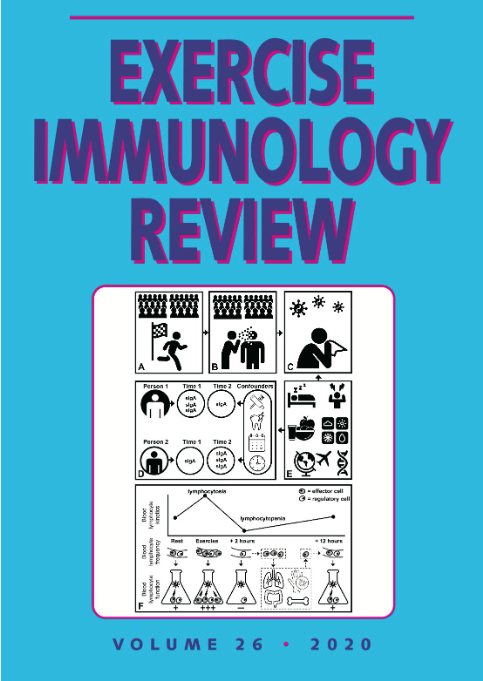健康青年男性优秀运动员急性运动后感染易感性的开放窗口期。
摘要
“打开窗户”理论的特点是,在剧烈的耐力运动后,免疫系统会受到短期抑制。这个机会之窗可能会增加上呼吸道疾病(URI)的易感性。许多研究表明,运动后免疫功能会下降。然而,许多研究并没有表明运动结束后2小时后免疫功能的变化,因此无法确定这些免疫细胞的数量,或者更重要的是它们的功能,是否会在另一轮运动开始前恢复到静止水平。10名男子“A”级单车手(年龄24.2 +/- 5.3岁);体重73.8 +/- 6.5 kg;vo2峰值65.9 +/- 7.1 mL x kg(-1) x min(-1)),在第二次通气阈值的90%下运动2小时。分别在运动前、运动后立即、运动后2小时、4小时、6小时、8小时和24小时采集血样。检测的免疫变量包括白细胞总数、中性粒细胞功能(氧化爆发和吞噬功能)、淋巴细胞亚群计数(CD4+、CD8+和CD16+/56+)、自然杀伤细胞活性(NKCA)和NK表型(CD56dimCD16+和CD56(亮)CD16-)。从运动前到运动后,淋巴细胞总数显著增加(p < 0.01),运动后2小时淋巴细胞总数显著减少(p < 0.001)。CD4+ t细胞计数在运动前、运动后4小时和运动后6小时均显著升高(p < 0.05)。NK (CD16+/56+)细胞数量从运动前到运动后4 h (p < 0.05)、运动后6 h (p < 0.05)和运动后8 h (p < 0.010)显著下降。相比之下,CD56(亮)CD16- NK细胞计数从运动前到运动后立即显著增加(p < 0.01)。中性粒细胞氧化爆发活性在运动后无显著变化,而中性粒细胞计数在运动前、运动后立即(p < 0.05)和运动后2小时(p < 0.01)均显著增加,且在运动后8小时仍显著高于运动前水平(p < 0.01)。运动后2小时、运动后6小时和运动后24小时中性粒细胞吞噬功能显著降低(p < 0.05)。最后,运动后2小时至6小时,以及运动后8小时,嗜酸性细胞计数均显著升高(p < 0.05)。这是第一个显示运动后8小时免疫变量变化的研究,包括明显的NK细胞抑制,NK细胞表型改变,总淋巴细胞计数显著增加,嗜酸性细胞计数显著增加,这些都在运动后8小时发生。运动后总淋巴细胞计数、NK细胞计数和中性粒细胞吞噬功能的抑制可能是引起定期高强度耐力训练后URI发生率增加的重要原因。The 'open window' theory is characterised by short term suppression of the immune system following an acute bout of endurance exercise. This window of opportunity may allow for an increase in susceptibility to upper respiratory illness (URI). Many studies have indicated a decrease in immune function in response to exercise. However many studies do not indicate changes in immune function past 2 hours after the completion of exercise, consequently failing to determine whether these immune cells numbers, or importantly their function, return to resting levels before the start of another bout of exercise. Ten male 'A' grade cyclists (age 24.2 +/- 5.3 years; body mass 73.8 +/- 6.5 kg; VO2peak 65.9 +/- 7.1 mL x kg(-1) x min(-1)) exercised for two hours at 90% of their second ventilatory threshold. Blood samples were collected pre-, immediately post-, 2 hours, 4 hours, 6 hours, 8 hours, and 24 hours post-exercise. Immune variables examined included total leukocyte counts, neutrophil function (oxidative burst and phagocytic function), lymphocyte subset counts (CD4+, CD8+, and CD16+/56+), natural killer cell activity (NKCA), and NK phenotypes (CD56dimCD16+, and CD56(bright)CD16-). There was a significant increase in total lymphocyte numbers from pre-, to immediately post-exercise (p < 0.01), followed by a significant decrease at 2 hours post-exercise (p < 0.001). CD4+ T-cell counts significantly increased from pre-exercise, to 4 hours post- (p < 0.05), and 6 hours post-exercise (p < 0.01). However NK (CD16+/56+) cell numbers decreased significantly from pre-exercise to 4 h post-exercise (p < 0.05), to 6 h post-exercise (p < 0.05), and to 8 h post-exercise (p < 0.01O). In contrast, CD56(bright)CD16- NK cell counts significantly increased from pre-exercise to immediately post-exercise (p < 0.01). Neutrophil oxidative burst activity did not significantly change in response to exercise, while neutrophil cell counts significantly increased from pre-exercise, to immediately postexercise (p < 0.05), and 2 hours post-exercise (p < 0.01), and remained significantly above pre-exercise levels to 8 hours post-exercise (p < 0.01). Neutrophil phagocytic function significantly decreased from 2 hours post-exercise, to 6 hours post- (p < 0.05), and 24 hours post-exercise (p < 0.05). Finally, eosinophil cell counts significantly increased from 2 hours post to 6 hours post- (p < 0.05), and 8 hours post-exercise (p < 0.05). This is the first study to show changes in immunological variables up to 8 hours post-exercise, including significant NK cell suppression, NK cell phenotype changes, a significant increase in total lymphocyte counts, and a significant increase in eosinophil cell counts all at 8 hours post-exercise. Suppression of total lymphocyte counts, NK cell counts and neutrophil phagocytic function following exercise may be important in the increased rate of URI in response to regular intense endurance training.

 求助内容:
求助内容: 应助结果提醒方式:
应助结果提醒方式:


